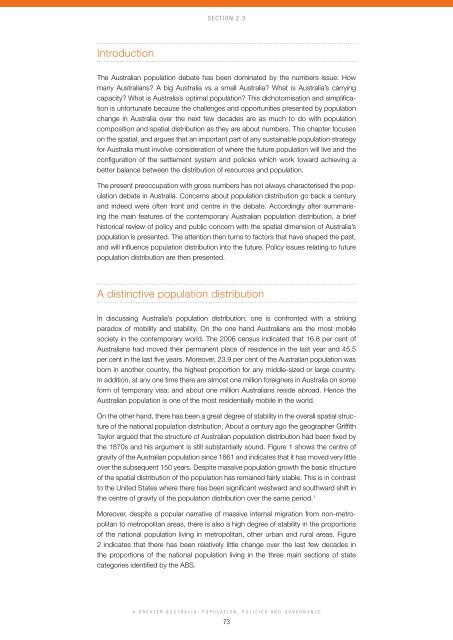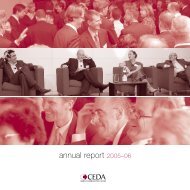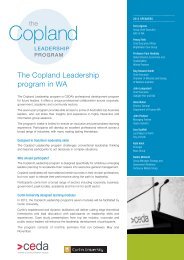A Greater Australia: Population, policies and governance - CEDA
A Greater Australia: Population, policies and governance - CEDA
A Greater Australia: Population, policies and governance - CEDA
- No tags were found...
You also want an ePaper? Increase the reach of your titles
YUMPU automatically turns print PDFs into web optimized ePapers that Google loves.
Section 2.3IntroductionThe <strong>Australia</strong>n population debate has been dominated by the numbers issue: Howmany <strong>Australia</strong>ns? A big <strong>Australia</strong> vs a small <strong>Australia</strong>? What is <strong>Australia</strong>’s carryingcapacity? What is <strong>Australia</strong>’s optimal population? This dichotomisation <strong>and</strong> simplificationis unfortunate because the challenges <strong>and</strong> opportunities presented by populationchange in <strong>Australia</strong> over the next few decades are as much to do with populationcomposition <strong>and</strong> spatial distribution as they are about numbers. This chapter focuseson the spatial, <strong>and</strong> argues that an important part of any sustainable population strategyfor <strong>Australia</strong> must involve consideration of where the future population will live <strong>and</strong> theconfiguration of the settlement system <strong>and</strong> <strong>policies</strong> which work toward achieving abetter balance between the distribution of resources <strong>and</strong> population.The present preoccupation with gross numbers has not always characterised the populationdebate in <strong>Australia</strong>. Concerns about population distribution go back a century<strong>and</strong> indeed were often front <strong>and</strong> centre in the debate. Accordingly after summarisingthe main features of the contemporary <strong>Australia</strong>n population distribution, a briefhistorical review of policy <strong>and</strong> public concern with the spatial dimension of <strong>Australia</strong>’spopulation is presented. The attention then turns to factors that have shaped the past,<strong>and</strong> will influence population distribution into the future. Policy issues relating to futurepopulation distribution are then presented.A distinctive population distributionIn discussing <strong>Australia</strong>’s population distribution, one is confronted with a strikingparadox of mobility <strong>and</strong> stability. On the one h<strong>and</strong> <strong>Australia</strong>ns are the most mobilesociety in the contemporary world. The 2006 census indicated that 16.8 per cent of<strong>Australia</strong>ns had moved their permanent place of residence in the last year <strong>and</strong> 45.5per cent in the last five years. Moreover, 23.9 per cent of the <strong>Australia</strong>n population wasborn in another country, the highest proportion for any middle-sized or large country.In addition, at any one time there are almost one million foreigners in <strong>Australia</strong> on someform of temporary visa; <strong>and</strong> about one million <strong>Australia</strong>ns reside abroad. Hence the<strong>Australia</strong>n population is one of the most residentially mobile in the world.On the other h<strong>and</strong>, there has been a great degree of stability in the overall spatial structureof the national population distribution. About a century ago the geographer GriffithTaylor argued that the structure of <strong>Australia</strong>n population distribution had been fixed bythe 1870s <strong>and</strong> his argument is still substantially sound. Figure 1 shows the centre ofgravity of the <strong>Australia</strong>n population since 1861 <strong>and</strong> indicates that it has moved very littleover the subsequent 150 years. Despite massive population growth the basic structureof the spatial distribution of the population has remained fairly stable. This is in contrastto the United States where there has been significant westward <strong>and</strong> southward shift inthe centre of gravity of the population distribution over the same period. 1Moreover, despite a popular narrative of massive internal migration from non-metropolitanto metropolitan areas, there is also a high degree of stability in the proportionsof the national population living in metropolitan, other urban <strong>and</strong> rural areas. Figure2 indicates that there has been relatively little change over the last few decades inthe proportions of the national population living in the three main sections of statecategories identified by the ABS.A <strong>Greater</strong> <strong>Australia</strong>: <strong>Population</strong>, Policies <strong>and</strong> Governance73





